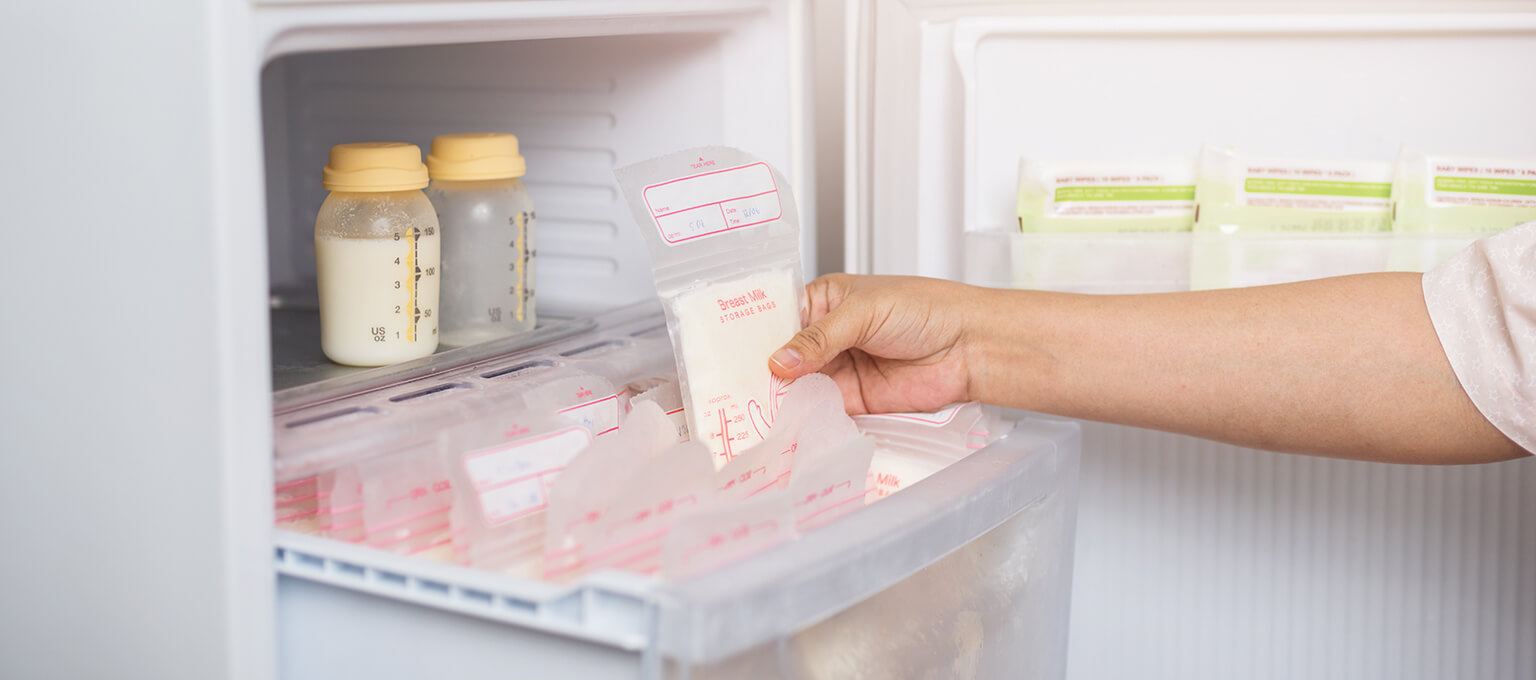
How to Store Breast Milk: All About Proper Storage
If you’re breastfeeding, there are lots of reasons you might want to store your breast milk. Maybe you want to pump or express while you’re at work and store your milk to give to your baby later, or perhaps you want to set aside a few bottles so someone else can feed your little one.
Read on to learn how to collect and safely store breast milk, and how to defrost and reheat breast milk that you've kept in storage.
How to Collect and Store Breast Milk
Whether you have an abundant supply of breast milk and want to put some aside for later use, or if you're going back to work while still breastfeeding and need to share some of the feeding duties with your partner or a babysitter, you might need to collect breast milk for storage.
Types of Breast Milk Storage Containers
Here are some options for storing breast milk and the recommended containers to use:
Some baby bottles are designed so you can store breast milk in them right after pumping. Read up on baby bottles for more info on them.
Portioning the Breast Milk for Storage
Keep your breast milk in portions of two to four ounces. That's typically the right amount for one feeding, helping to minimize waste.(read more on breastfeeding)
Label whichever storage container you’ve chosen with the date of pumping, and with your baby's name if the milk will be consumed at day care. Always use the oldest stored breast milk first, as long as it’s still within its use-by limit.
If you’re going to place the container in the freezer for storage, make sure to leave an inch of air space at the top since the liquid will expand when frozen.
Hygiene Guidelines for Pumping Breast Milk
There are some steps you can take to prevent transmitting bacteria to the breast milk and to your baby.
Before using your breast pump for the first time, make sure to sterilize all its parts, including the nipples, bottles, and any parts that come into contact with your breasts or the milk.
Sterilize by boiling the parts for 5 to 10 minutes. Check the manufacturer’s directions for sterilizing and follow the recommended boiling time in case it’s a little different.
Each time you use the pump, make sure to wash your hands thoroughly.
After every time you use the pump, make sure to wash the parts in hot, soapy water, or in the dishwasher if the parts are dishwasher safe.
Time Guidelines for Breast Milk Storage
Freshly expressed or pumped breast milk can be stored in several ways.Whether you’d like to know how long you can store your breast milk in the fridge or freezer, or how long can breast milk stay out at room temperature, here are the maximum times it can safely be stored for:
Fresh Breast Milk Storage Times
If the breast milk is left over from a previous feed it must not be stored and should be used within 2 hours or discarded.
Thawed breast milk can be kept at room temperature for 1 to 2 hours before use, or kept in the fridge for up to 24 hours before use.
Thawed breast milk must never be refrozen!
How to Defrost Frozen Breast Milk
Follow these tips for thawing breast milk stored in the freezer:
Can You Reheat Chilled Breast Milk?
Yes. Breast milk that’s been stored in the refrigerator, whether it’s been previously frozen or not, can be reheated if you’d like to give your baby warm milk. But know that breast milk does not need to be given to your baby warm. It’s OK to feed your baby breast milk that’s chilled or at room temperature.
After taking breast milk out of the fridge, you might wonder how long is breast milk good after taking out of fridge . Generally, once breast milk reaches room temperature, it can be kept for up to 2 hours before it should be discarded.
If you wish to reheat breast milk after storage in the fridge, follow these steps:
Is Stored Breast Milk Any Different From Fresh Breast Milk?
Breast milk that’s been in storage, either in the refrigerator or thawed from the freezer, can look different from freshly expressed or pumped breast milk. It may even separate into a creamy layer and a milky layer. This is completely normal. Gently swirl the milk to mix it back together.
Thawed frozen milk may also smell or taste different due to a breakdown in the milk fats. It’s still safe for your baby, and most babies won’t notice the difference.
You can try mixing the previously chilled breast milk from storage with fresh breast milk in a 1:1 ratio. It’s best that the two milks are close in temperature when you do this.
If your baby doesn’t finish the bottle of stored milk, the leftover breast milk can still be used within two hours. After that, it should be discarded.
FAQS AT A GLANCE
If you’ve removed breast milk from the refrigerator after a period of storage, once it reaches room temperature, it can be kept at up to 77 degrees F for up to 4 hours.
The Bottom Line
For busy moms like you, expressing or pumping breast milk and then storing it can be a lifesaver. Having breast milk in storage can make it easier to keep up with your baby’s feedings and allow you to share feeding duties with others. Using the info in this article and giving it a try, you’ll soon get the hang of storing, thawing, and reheating breast milk, and it will become a natural part of your life with your little one.
After all those feedings, you’ll be doing a lot of diaper changes! To earn Pampers Cash for all those diaper purchases, download the Pampers Rewards app today.
- CDC: Handling Breast Milk
- KidsHealth: Breastfeeding Storing
- Cleveland Clinic: Breast Milk Storing
- Mayo Clinic: Breast Milk Storage
- Book: Your Pregnancy and Childbirth: Month to Month , Sixth Edition Paperback – January 1, 2016 by American College of Obstetricians and Gynecologists (Author)
- Book: Caring for Your Baby and Young Child: Birth to Age 5 , Sixth Edition Paperback – November 2, 2014 by American Academy of Pediatrics (Author)
Read more about Baby
Related Articles
Join a World of Support
through Pregnancy and Parenthood.
TRACK WITH TOOLS
LEARN WITH EXPERTS
GET REWARDED













